CORAL CORES: OCEAN TIMELINES

Coral Skeleton Growth
Most people are familiar with the growth rings seen in tree cross-sections, but few are aware that similar growth patterns are visible in skeletons of reef-building corals.
Beneath the thin layer of living tissue at the top of a coral colony, the polyps of reef-building corals lay down hard layers of calcium carbonate. This is what we consider the hard, or stony, part of the reef--the coral skeleton.
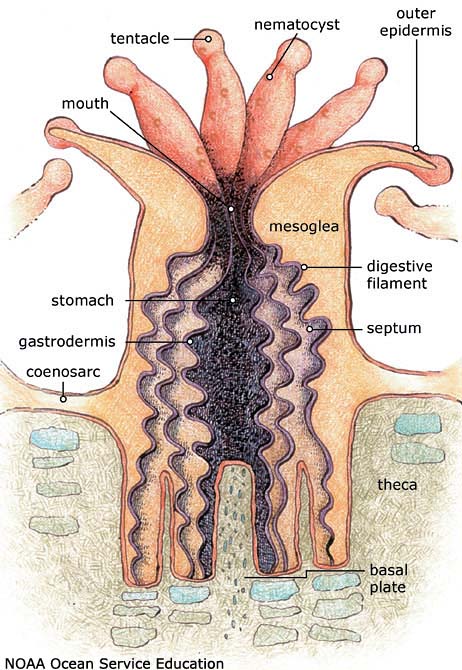
Basal plates are the sections of skeleton being
layed down by coral polyps.
As coral colonies grow, the structure and chemistry of these layers is affected by variations in the temperature and water composition around them. This makes them suitable climate proxies. In other words, the information in their layers can tell us what the local climate was like at the time they were created.
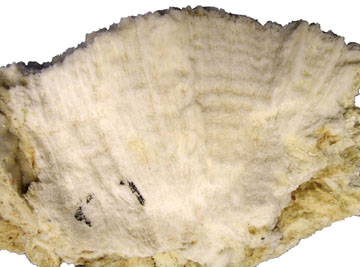
Layers of growth are slightly visible on the underside of this
brain coral (Pseudodiploria strigosa) skeleton. Photo: FGBNMS/Drinnen
At Flower Garden Banks National Marine Sanctuary, scientists have determined that coral skeletons tend to grow more rapidly in fall and winter months, when temperatures are more moderate (72-77F= 22-25C). When temperatures are closer to the corals' outer tolerance levels (68F and 84F= 20C and 29C), growth is slower. The result is an identifiable series of growth bands.
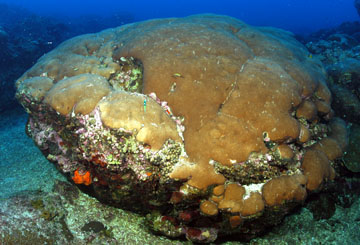
At Flower Garden Banks National Marine Sanctuary there are many large coral colonies, with potential for a lot of data.
Photo: FGBNMS/Schmahl
top of page
Coral Coring
In order to see these layers, scientists drill cores out of large coral heads. This gives them a look at many years-worth of layers in one compact unit. The larger the coral colony, the more years of data they can extract.
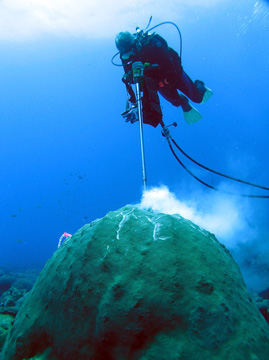
A diver drilling a core from a colony of
Orbicella (Montastraea) faveolata in 2005.
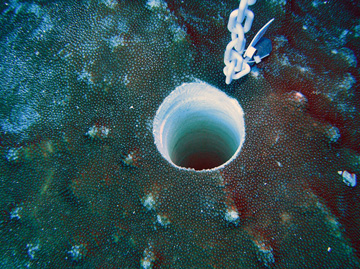
The hole in the coral colony from which the core was extracted.
(The weighted piece of chain sitting to one side was used as a marker to show where the core should be drilled.)
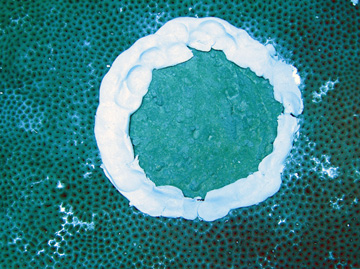
After the core was removed, a cement plug was placed in the openeing and sealed with epoxy to prevent further injury to the coral colony. The coral polyps eventually grow over this patch, completely hiding it beneath new layers of skeleton.
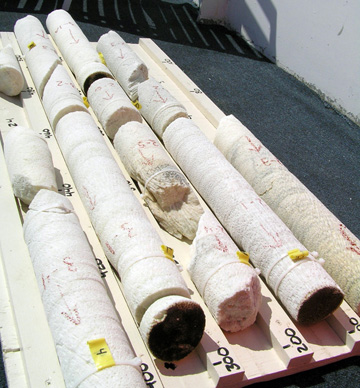
These are the core pieces that were extracted
in 2005.
top of page
Core Analysis
 X-rays of coral cores make it easier for scientists to examine the annual growth bands in reef-building corals. Dark bands show the slow, high-density growth that takes place during the summer. Lighter bands show the faster, low-density growth that takes place during the winter.
X-rays of coral cores make it easier for scientists to examine the annual growth bands in reef-building corals. Dark bands show the slow, high-density growth that takes place during the summer. Lighter bands show the faster, low-density growth that takes place during the winter.
Scientists can take a look back in time to determine when temperatures were warmer or cooler, by simply examining the depth of each growth band. Larger low-density bands indicate warmer winter temper-atures. Slightly darker bands, known as stress bands, indicate periods of environmental stress, such as temperature extremes. (see labeled image below)
Within each band scientists can also evaluate the chemical content to learn more about atmospheric conditions. By drilling out 12 tiny samples from each growth band, they can examine the oxygen and carbon isotopes to determine specific temperatures during each month of the year.
This image shows x-rays of two coral core samples extracted from colonies of Orbicella (Montastrea) faveolata and Siderastrea siderea at East and West Flower Garden Banks in 2005.
Scientists from Texas A&M University analyzed these core samples to identify patterns in growth over periods of time. They then compared these to what we know of air and water temperature readings in the region to help them evaluate cores that go back farther than recorded data, and "read" climate history.
top of page
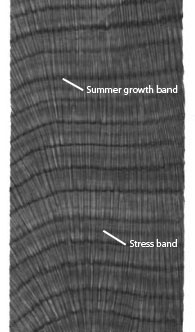
X-ray image of a coral core showing growth lines.
Image: Amy Bratcher, Texas A&M University
This gathering and analysis of climate data from natural recorders such as coral skeleton layers, tree rings, ice cores, etc. is known as paleoclimatology.
Why do we want to do all of this? Understanding how climate has affected the Gulf of Mexico over a period of years, decades, or even centuries may help us recognize and anticipate future climate changes, so that we can appropriately manage our marine resources.
Coral Cores Lesson
We have also developed an educational lesson using x-ray images from coral cores.
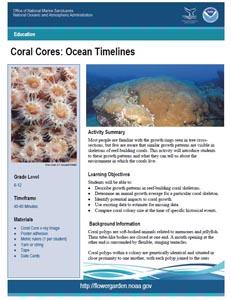
Download Coral Cores: Ocean Timelines Lesson (6MB pdf)
See what other lessons are available by visiting our For Teachers page.
Additional Information
NOAA Paleoclimatology website
Investigation of a Northern Gulf of Mexico brain coral, Diploria strigosa, for climate reconstructions, Poster, 2012 (4.7MB pdf)
Coral Coring in Flower Garden Banks National Marine Sanctuary--A Collaborative Effort, USGS Sound Waves, July 2005 (195kb PDF)
Coral Cores from the Flower Gardens: A New Tool for Studying Climate, Quarterdeck, 1995 (438kb PDF)
top of page